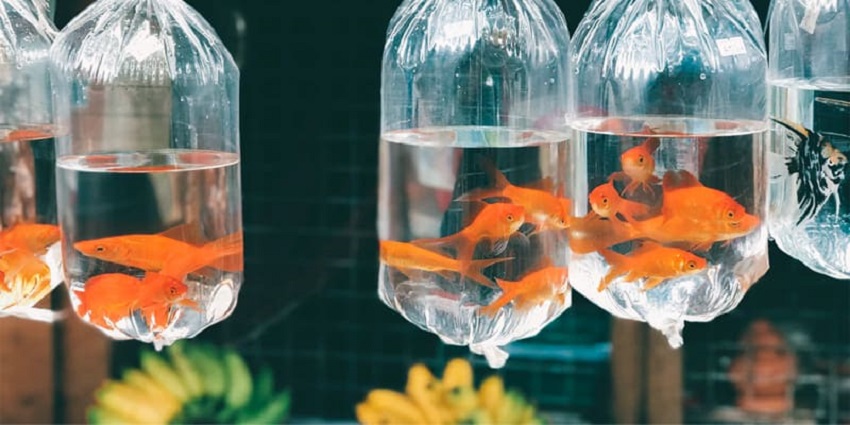
It should be noted that the vast majority of transporters and the post office itself do not accept shipments of live animals and therefore cannot transport fish. The reason is obvious. They need to be handled and stored in a much more accurate way than a normal package. In this sense, the few transporters authorized and equipped are mostly oriented to a professional user. Let’s discover how to transport fish safely.
How to transport fish?
Using an unauthorized courier implies the possibility of incurring penalties. In the extreme, the hypothesis of mistreatment could also be configured and a not too remote risk of killing animals. Therefore, we feel we advise against this type of practice. We are suggesting that you entrust the transport to a trusted person or provide it directly. Having made this necessary premise, below we report the essential precautions to be taken to transport live animals, some also valid for short journeys, such as from the shop to your home.
The bag
The first plastic bag we find is not suitable for transporting fish. They must be of a specific type for aquariums, made of sturdy polyethylene and a rounded bottom edge. This precaution means that the fish cannot get stuck in the edges once the bag is placed and suffocate or crush it. If we have old-style bags (without rounded edges), this can be remedied by closing the corners with packing tape.
The procedure for rounding corners with scotch tape
Avoid frozen food bags like the plague: too much, too fragile (they were not born to be filled with water).
The bag must be sized according to the fish to be transported. Obviously, the bigger it is, the better, since more air and water will be available for the animal.
To close the bag, strong rubber bands are used and, after closing the bag quickly. So, the end remains swollen and rolled upon itself, we proceed with a binding as shown in the photos:
There are also breathable bags, which have the particularity of letting the air pass inside, not letting the water escape. They are very useful on long journeys (days) or in expeditions. Of course, they have a higher cost than the classic polyethylene bag.
Water and air
Since the fish breathes in water, many think that most of the bag must be filled with water. Wrong! The fish will stay in the water, but what it breathes is oxygen, which is transferred to the water through the air! Therefore, you only need to fill 1/3 of the bag with water, to have a sufficient air reserve. If the journey is particularly long and in shipment, it is advisable to inflate the bag with oxygen using a special cylinder. Note: avoid inflating by mouth, as the air introduced would be largely composed of carbon dioxide!
For expeditions, the use of anesthetic is not uncommon (especially among professionals in the sector). A few drops in the bag make the fish calmer, limiting stress and oxygen consumption.
The breathable bags illustrated in the previous chapter can be used to further favor the reserve of air available to the fish.
Preparing the bag for transport
Do you know when you pass from a closed and dark place directly into the sunlight? An annoying sensation for the eyes. Well, the same thing can happen to our wrapped fins if we leave the shop (especially in the summer) with the bag in hand in plain sight, since the light of the tub and the shop is not in the least comparable to that of the sun. The darkness calms the animal, so it would be advisable to put the bag in a closed bag or wrap it with a sheet of newspaper if we do not have it.
One of the most nefarious dangers is the thermal shock, a problem that makes itself felt heavily in such a small volume of water. The critical periods are late autumn-winter and summer: opposite temperatures, same problem. To make the bag more resistant to temperatures, it must be insulated. In the case of less critical periods (autumn, late spring), a double or triple bandage in newsprint may suffice. It is better to provide a round of bubble wrap (plastic packing with bubbles).
The transport container
Another practical method to transport and protect from unfavorable temperatures is to use insulated containers. The most used are three: thermal bag, portable fridge and polystyrene box.
The thermal bag is convenient if we have to carry a single bag and we are not in a prohibitive time of year regarding temperatures, given its reduced insulation thickness.
The portable camping fridge is something that practically everybody year and is very suitable for our purpose. As the walls are large and well insulated. It is hermetically resealable (preventing the entry of outside air) and, not a small thing, it is equipped with a handle. The only negative point is that it does not have an excessive capacity. But unless we have to transport the population of a whole 400lt, it is fine in many cases.
The polystyrene box is a container made entirely of this material, with an airtight interlocking lid. It is available directly from aquarium shopkeepers (the packaging used for all shipments) from warehouses. We can make it at home by lining a box or a wooden box with polystyrene plates (recommended thickness: at least 3cm). It has the same characteristics as the portable fridge, which is produced in various sizes. If we give ourselves to do-it-yourself, we can indulge ourselves in shapes and sizes.
The bucket
If we have to transport large fish such as large adult cichlids (astronotus, nimbochromis, cyphotilapia, … ..), which would be difficult, if not impossible, to transport in a bag, we can use a bucket.
Perfect for this purpose are the painter’s ones available in any do-it-yourself shop: good size (about 18lt), sturdy, low cost, and equipped with handle and lid. Note: do not use recycled buckets that have contained paint or other toxic materials.
The bucket must be considered a big bag. Therefore the rules on the air/water ratio and the treatment of this remain the same.
To improve gas exchange, using a battery-powered aerator may be useful, especially if we carry a lot of fish.
It is necessary to pack the animals individually, avoid putting too much water (which is not needed), and possibly using a double, if not triple, bag. This precaution is mandatory in some particularly sharp SPS species that will surely puncture the first bag. Also, for this reason, it is not necessary to exaggerate the amount of water, bearing in mind that many corals survive for several hours even in a humid condition that does not necessarily correspond to a complete soak.
You may also like to read, What if there’s a skinny layer of ice between my vehicle and therefore the automotive cover?
